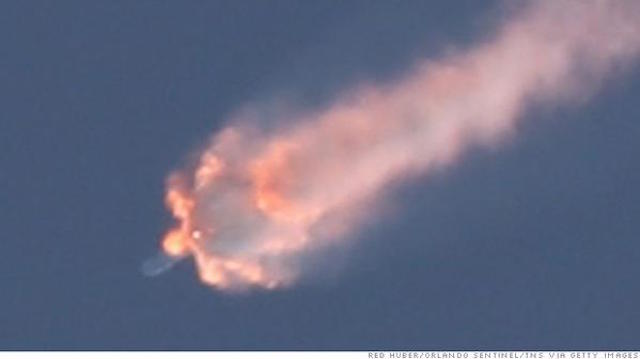Every strut counts, as we say. On 28 June, a SpaceX Falcon 9 rocket carrying a Dragon capsule stuffed full of supplies for the International Space Station blew up in mid-air, minutes after launch from Cape Canaveral, Florida. Today, Elon Musk revealed the cause: A single, flimsy strut.
As Musk told members of the press at a teleconference this afternoon, shortly after launch a steel strut holding a helium tank in place in the rocket’s second stage snapped. Helium bottles are stored within the rocket’s liquid oxygen fuel tank to provide pressure as the rocket consumes fuel during flight. The incident set off a chain reaction that consumed the rocket before any counter measures could be taken.
The strut, which came from a SpaceX supplier, appeared undamaged before launch. Musk assumed full responsibility for the failure and promised that, going forward, there will be rigorous in-house certification of rocket parts from suppliers, independent of any material certifications.
Another key takeaway from the failure is the need for better monitoring software within Dragon VI capsules, so that payloads can deploy parachutes and escape in the event of future mishaps. The recent failure eviscerated 4,000 pounds of supplies, including food, fuel, hardware, 30 student projects and two HoloLens devices.
Learning #SpaceX rocket failure seems to be simple internal part giving way. Founder says software couldve saved it. https://t.co/RhLvJ7Acwt
— Grayson Kamm (@graysonkamm) July 20, 2015
SpaceX engineers have spent the last several weeks analysing 3,000 channels of telemetry data to parse what could have happened during those final few seconds of flight. Before today, the only word we’d had from the private rocket company on the failure was a tweet from Musk, stating that it could have been the result of an overpressure event in rocket’s oxygen tank:
There was an overpressure event in the upper stage liquid oxygen tank. Data suggests counterintuitive cause.
— Elon Musk (@elonmusk) June 28, 2015
Musk has been up-front about the fact that the launch failure — the very first of its kind for SpaceX — could be a major blow to the company, which currently has a multi-billion dollar contract with NASA to ferry supplies to the ISS, and is expected to start bringing human astronauts into orbit as soon as 2017. But today, we didn’t hear any indication that SpaceX’s timeline for manned launches is going to be pushed back.
We’re moving forward, it seems — albeit a bit more cautiously than before. As SpaceX likes to remind us, rockets are hard. In this case, at least, there seems to be a straightforward solution: More Struts. Better Struts.
